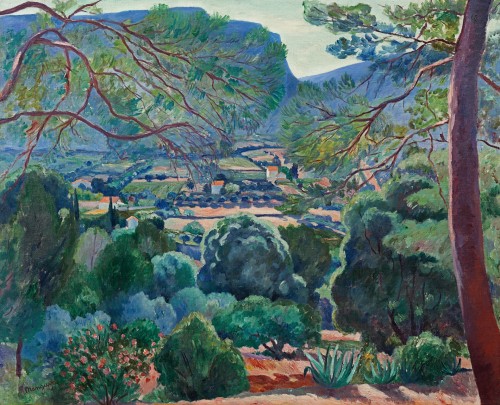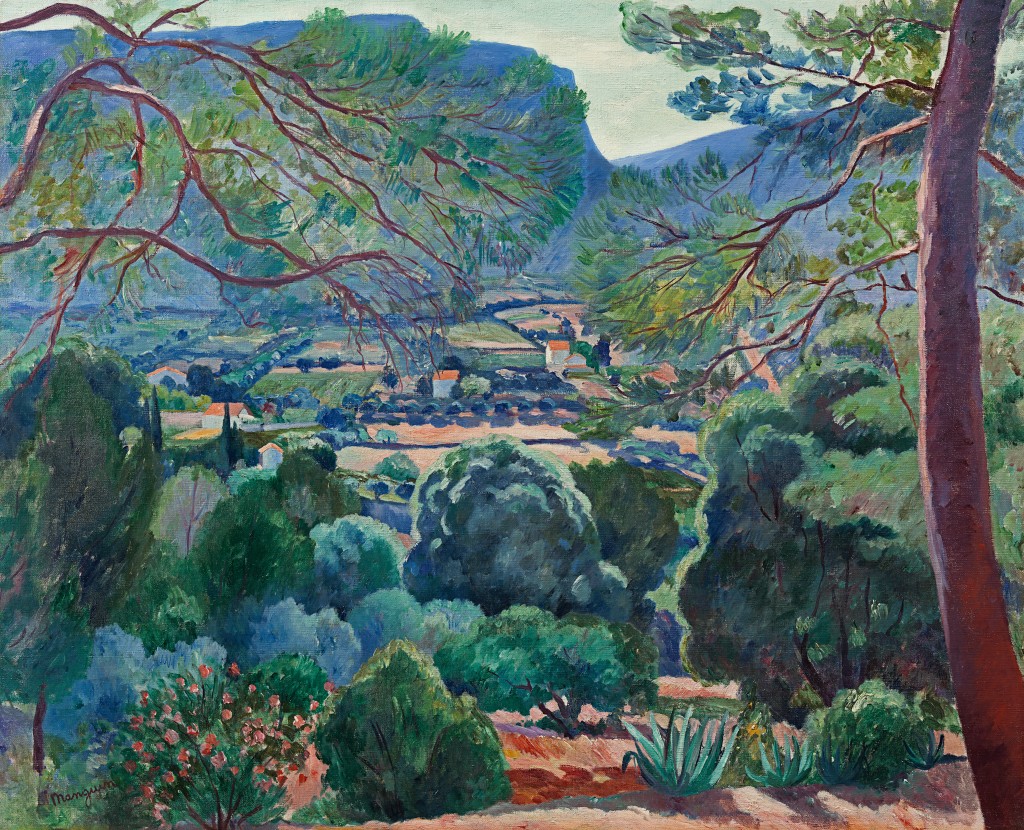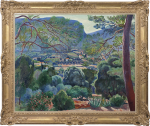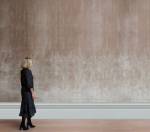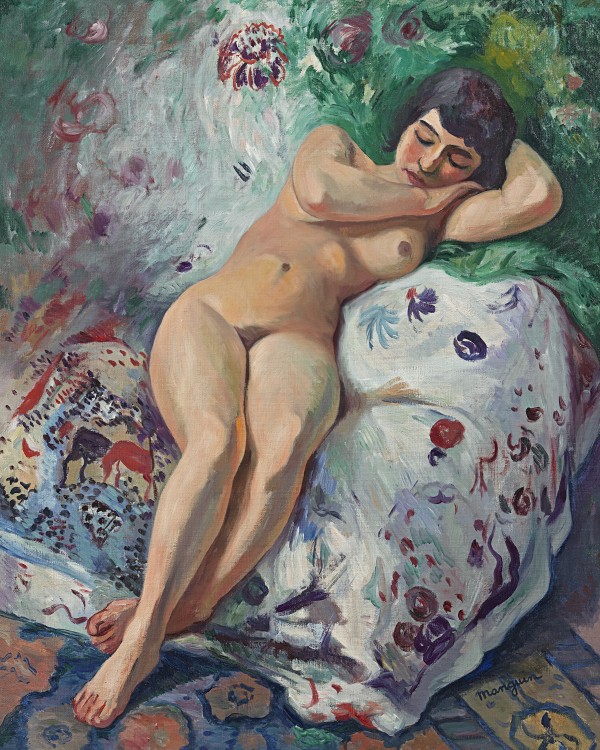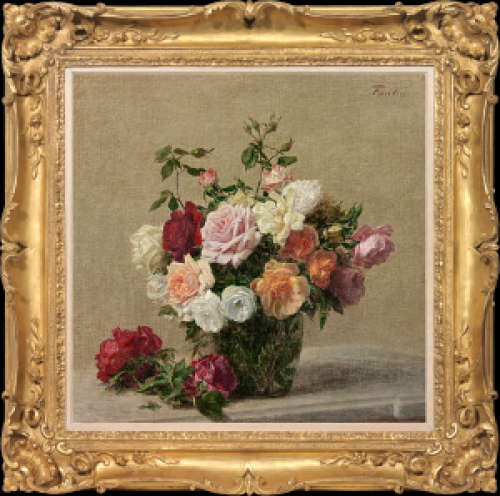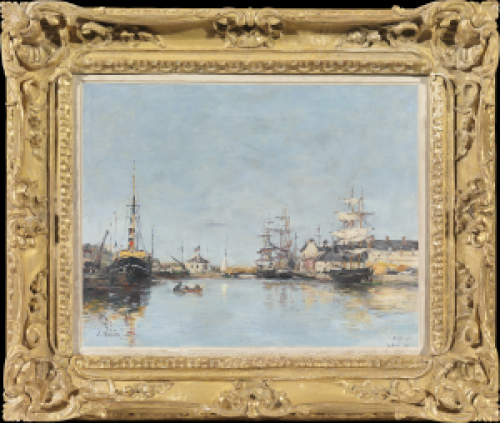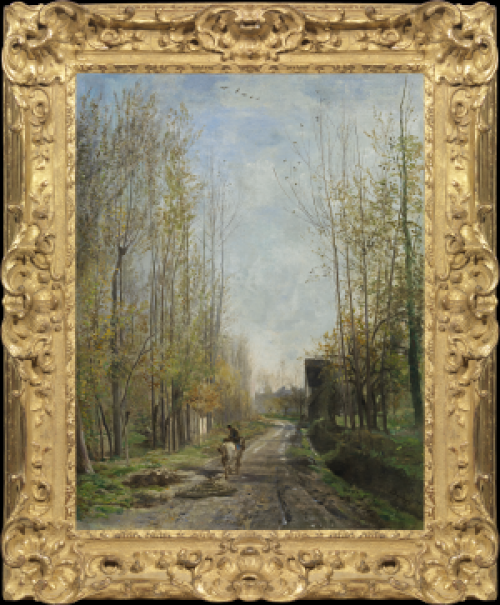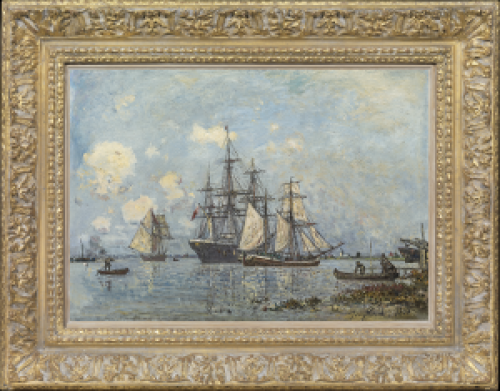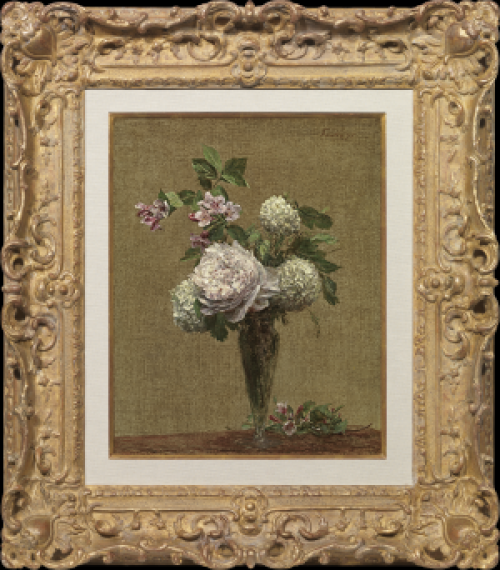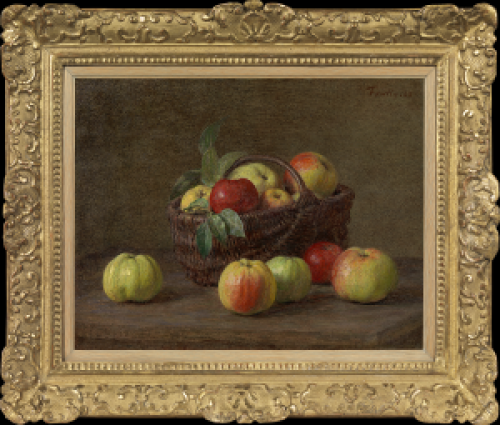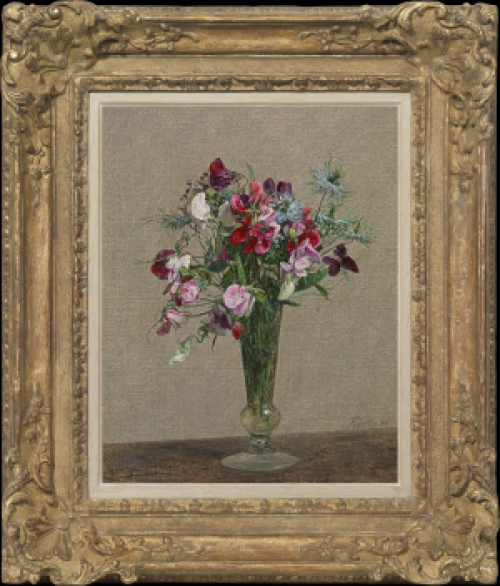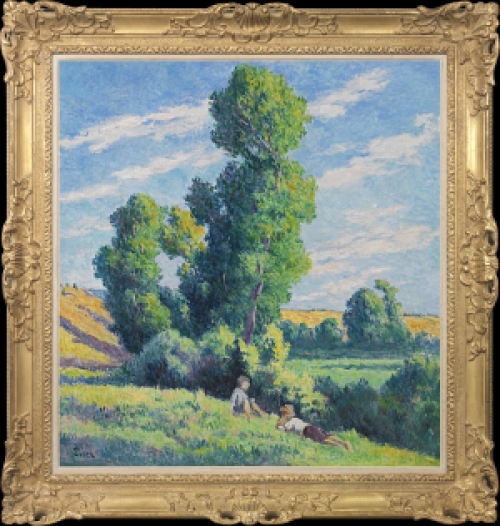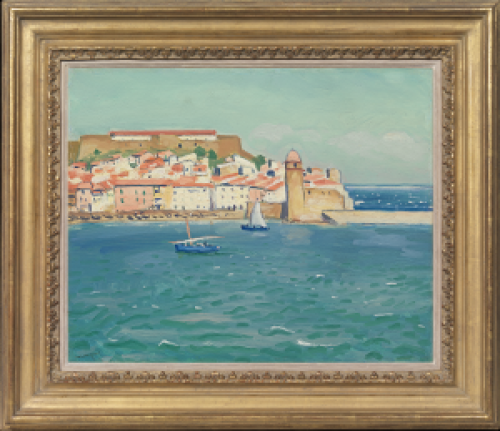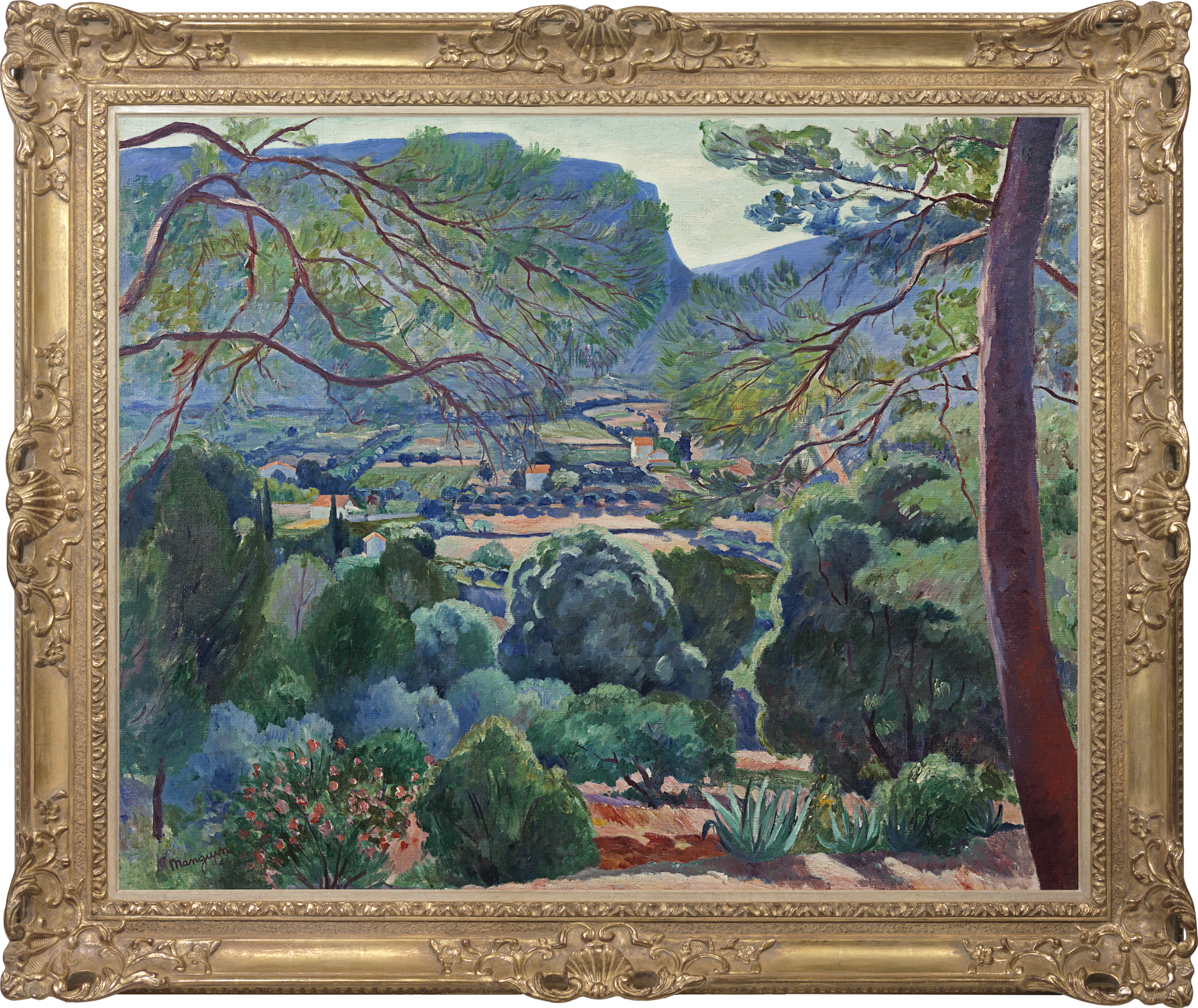HENRI MANGUIN
Paris 1874 - 1949 St Tropez
Ref: CC 127
Le Pas de la Colle, Cassis
Signed lower left: Manguin
Oil on canvas: 32 ¼ x 39 ¾ in / 81.9 x 101 cm
Frame size: 41 x 49 in / 104.1 x 124.5 cm
In a Louis XIV style gilded composition frame
Painted in summer or autumn 1912
Provenance:
Acquired from the artist by Galerie E Druet, Paris, in December 1912, inv. no.7166
Joachim Gasquet (1873-1921), Paris, 1913
Private collection, Vauxrezis dans l’Aisne, Hauts de France, acquired circa 1923;
private collection, France
Exhibited:
Paris, Galerie E Druet, Manguin, 28th April-10th May 1913, no.25
Literature:
Marie-Caroline Sainsaulieu, Henri Manguin Catalogue Raisonné de l’Oeuvre Peint sous la Direction de Lucile et Claude Manguin, Neuchâtel 1980, p.169, no.428, illus.
Henri Manguin was a pupil with Matisse, Marquet, Rouault and Camoin in the studio of Gustave Moreau, a liberal teacher who sensed the ferment of originality in these young men: he told them that he was the bridge over which they would pass. They sprang to notoriety at the 1905 Salon d’Automne, with paintings in which vivid, anti-naturalistic colour is used as a vehicle to express emotion. Perspective, paramount since the Renaissance, was jettisoned in favour of eddying black lines and a pulsating picture plane. The outraged critic Louis Vauxcelles dubbed these artists ‘fauves’ (wild beasts).
Manguin first visited Saint-Tropez in 1904, at the invitation of Paul Signac. Like so many of his artist contemporaries, he was seduced by the light of the South of France, eventually settling there permanently in the 1920s. From 1912 to 1914 he spent summers in Cassis, about twelve miles east of Marseille. The fishing village is famous for its precipitous cliffs and sheltered inlets, or calanques, where rocky limestone slopes, covered with maquis scrub, slope down to water of purest turquoise.
This view was made in 1912, when Manguin was staying in Cassis with his family and his friend Othon Friesz (1879-1949), a fellow member of the Fauve group. By 1912 both artists had modified their style from the extremes of the Fauve manner. Manguin’s painting looks inland towards the blue hills of the Mont du Président. Although more naturalistic in palette than his Fauve phase, it shows the bold simplification of modernist landscape and his genius as a colourist. The foreground is filled with trees and bushes of a serene monumentality, defined by a myriad of juxtaposed greens in softly blended, hatched brushstrokes. The intense southern light which irradiates the rounded forms throws into contrast the velvety depths of the shadows. A similarly instinctive, allusive approach to landscape can be seen in the work of Pierre Bonnard (1867-1947), who was painting in the South of France in the same period.
Manguin makes play of the widely contrasting shapes of the natural world, from the spiky agave plants to the spindly branches of the pines which frame the scene, fretted across the blue glow of the hills. The blues and blue-green of the vegetation are lightened by the pink flowers on the bush in the left foreground, the sandy-pink of the soil and bleached meadows and the terracotta roofs of the distant farmhouses. The light makes the scaly trunk of the pine glow with burgundy, ochre and purple hues. All seems breathlessly still and dreamlike in the heat, the reverie broken only by the sound of cicadas.
The motif of Provençal landscape backed by hills is influenced by the many Mont Sainte-Victoire paintings of Paul Cézanne, whom Manguin revered. However, Manguin’s work has none of the angularity of Cézanne: it is free and flowing, less an analysis than an emotional response to nature. The art historian Hans Hahnloser, son of Manguin’s Swiss patron Arthur Hahnloser, commented that ‘A la base de sa vision, il y a toujours une expérience, un impulsion causée par un enthousiasme passager’[1]. Le Pas de la Colle, Cassis is one of Manguin’s most arresting and imposing evocations of the seductive, timeless landscape of the South of France.
This painting was formerly in the collection of the Provençal poet and art critic Joachim Gasquet (1873-1921), a friend of Cézanne and Matisse who was part of the wider Fauve circle. He acquired more than one painting by Manguin, including La Citadelle de St Tropez, 1909 (private collection)[2].
HENRI MANGUIN
Paris 1874 – 1949 Saint-Tropez
Henri Manguin was born in Paris in 1874. In 1894 he entered the studio of Gustave Moreau at the Ecole des Beaux-Arts, a fellow pupil of Matisse, Marquet, Rouault, Valtat and Camoin, who remained lifelong friends. In 1899 he married his muse and model Jeanne Carette and in 1902 exhibited for the first time at the Salon des Indépendents. Manguin first discovered the South of France in 1904, when he was invited to Saint-Tropez by Paul Signac, with whom he shared a love of fast cars. The dazzling Mediterranean light had a profound effect on Manguin’s work. Manguin and his friends showed paintings with emotionally-charged, anti-naturalistic colour and shifting perspective at the 1905 Salon d’Automne, provoking the critic Louis Vauxcelles to dub them ‘fauves’ (wild beasts). The following year Ambroise Vollard bought 150 of Manguin’s works.
Manguin depicted nudes, landscapes, interior scenes and still lifes in a direct, painterly style, although the palette of his later work is softer and more naturalistic than that of his Fauve period. From the 1920s, like Matisse, he divided his time between Neuilly-sur-Seine to the west of Paris and the South of France, renting, then buying, a house called l’Oustalet at Saint-Tropez. Manguin also made painting trips to Normandy, Brittany and other parts of France and to Switzerland, where he gained important patrons through his friendship with Félix Vallottan. Manguin died at Saint-Tropez in 1949. In 1950 the Salon des Indépendents organized a major retrospective of his work.
The work of Henri Manguin is represented in the Musée d’Orsay, Paris; the Hermitage, St Petersburg; the Museo Thyssen-Bornemisza, Madrid; the Metropolitan Museum of Art, New York and the Art Institute of Chicago.
[1] Quoted in Sainsaulieu, op. cit., p.33.
[2] Sotheby’s London, 4th February 1909, lot 211.

